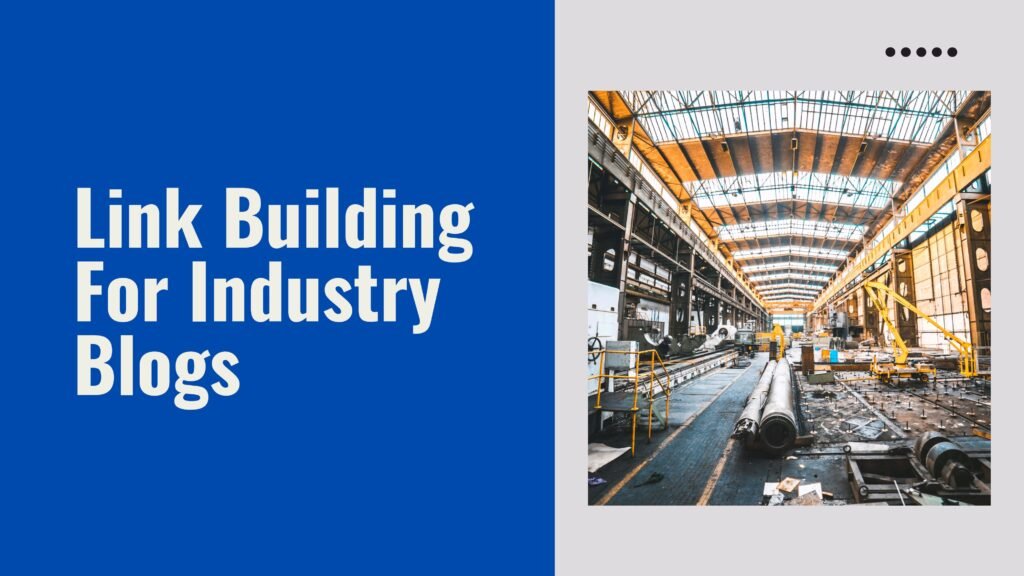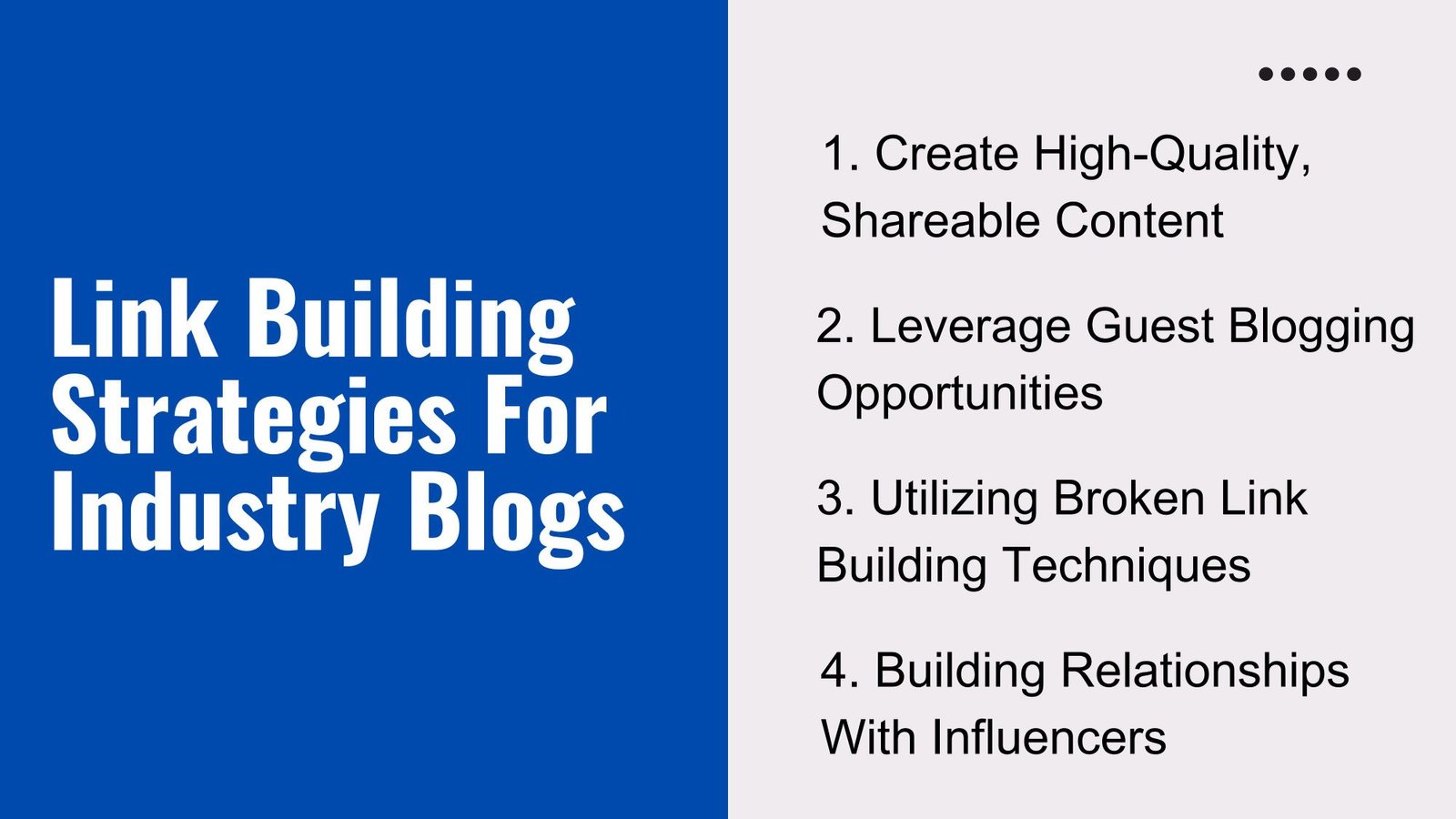
Link building is a crucial component of any successful digital marketing strategy, particularly for industry blogs seeking to enhance their online presence and authority. In the ever-evolving landscape of search engine optimization (SEO), link building remains a powerful tool for driving organic traffic, improving search engine rankings, and establishing credibility within a specific niche. As industry blogs continue to proliferate, the competition for visibility and readership intensifies, making effective link building more important than ever.
At its core, link building involves acquiring hyperlinks from other websites to your own, serving as a vote of confidence in the quality and relevance of your content. These backlinks not only help search engines like Google assess the authority and trustworthiness of your blog but also direct potential readers to your site, increasing the likelihood of engagement and conversion. For industry blogs, which often cater to a specialized audience, building a robust network of high-quality links can significantly enhance their reach and influence.
However, successful link building is not merely about quantity; it’s about quality and relevance. In the context of industry blogs, this means securing links from reputable sources within the same field, ensuring that the content is pertinent and valuable to the target audience. This approach not only boosts SEO performance but also fosters relationships with other thought leaders and influencers in the industry, opening doors to collaboration and knowledge sharing.
In this article, we will delve into the intricacies of link building for industry blogs, exploring strategies that can help you secure high-quality backlinks and elevate your blog’s standing in the digital realm. From understanding the importance of content quality and relevance to leveraging social media and guest blogging opportunities, we will provide actionable insights and practical tips to enhance your link-building efforts. Whether you’re a seasoned blogger or just starting, mastering the art of link building can propel your industry blog to new heights, ensuring it remains a valuable resource for your audience and a formidable player in your niche.
Why is Link Building For Industry Blogs Important?
Enhances Search Engine Visibility
Link building plays a crucial role in improving the visibility of industry blogs on search engines like Google. When reputable websites link to your blog, search engines interpret this as a sign of credibility and authority. As a result, your blog is more likely to rank higher in search results, attracting more organic traffic.
Builds Authority and Credibility
High-quality backlinks from authoritative industry sources help establish your blog as a trusted resource. This not only boosts your search engine rankings but also encourages visitors to view your content as reliable and valuable.
Drives Referral Traffic
Links from popular industry blogs and websites can generate direct referral traffic. When readers click on these links, they are directed to your blog, increasing your audience and potential customer base.
Fosters Industry Relationships
Engaging in link building often involves outreach and collaboration with other industry professionals. This process helps you build relationships, which can lead to future partnerships, guest posting opportunities, and shared audiences.
Supports Content Marketing Strategies
Link building complements your overall content marketing efforts by amplifying your content’s reach. When your blog is linked to by other reputable sites, it signals to search engines and users that your content is valuable, encouraging more sharing and engagement.
Improves Domain Authority
Consistent link building from relevant and authoritative sources increases your blog’s domain authority. A higher domain authority correlates with better search engine rankings and increased trustworthiness in your industry niche.
Increases Brand Awareness
When industry blogs and websites link to your content, it enhances your brand’s visibility within your niche. This recognition can lead to more opportunities, partnerships, and a stronger presence in your industry.
Key Benefits of Effective Link Building
- Higher Search Rankings: Improved visibility on search engines.
- Increased Organic Traffic: More visitors discovering your blog naturally.
- Enhanced Reputation: Recognition as an industry authority.
- Networking Opportunities: Building relationships with industry leaders.
- Long-term SEO Benefits: Sustained growth in search rankings over time.
Implementing a strategic link building approach for industry blogs is essential for establishing authority, increasing visibility, and driving targeted traffic. By focusing on quality over quantity and fostering genuine relationships within your industry, you can significantly enhance your blog’s performance and reputation.
Top Strategies For Link Building For Industry Blogs
 Effective link building is essential for boosting the authority and visibility of your industry blog. By acquiring high-quality backlinks, you can improve search engine rankings, drive targeted traffic, and establish your site as a trusted resource within your niche. Below are proven strategies to help you develop a robust backlink profile tailored specifically for industry blogs.
Effective link building is essential for boosting the authority and visibility of your industry blog. By acquiring high-quality backlinks, you can improve search engine rankings, drive targeted traffic, and establish your site as a trusted resource within your niche. Below are proven strategies to help you develop a robust backlink profile tailored specifically for industry blogs.
1. Create High-Quality, Shareable Content
The foundation of successful link building starts with producing valuable content that others want to reference and share. Focus on creating comprehensive guides, data-driven articles, expert roundups, or innovative insights relevant to your industry.
- In-depth Guides: Offer detailed tutorials or how-to articles addressing common challenges in your field.
- Original Research & Data: Publish unique studies or surveys that provide fresh insights—others will cite these sources.
- User-generated Content: Encourage community contributions like guest posts or testimonials which naturally attract links when shared widely.
2. Leverage Guest Blogging Opportunities
A well-executed guest blogging strategy not only builds relationships but also earns authoritative backlinks from reputable sites within the industry ecosystem.
- Select Relevant Sites: focus on blogs with strong domain authority related to your niche for maximum impact.
- Create Tailored Pitches:Pitch ideas aligned with their audience’s interests rather than generic topics.
- Add Value With Your Posts:Your content should be insightful and original enough to warrant sharing through backlinks.
3. Link Building for Industry Blogs: Strategies, Analysis
Link building for industry blogs is a vital part of a sustainable SEO strategy. It enhances domain authority, boosts search visibility, and positions your blog as a trusted voice within your niche. But beyond acquiring backlinks, success depends on continuous measurement, data-driven refinement, and ethical practices.
4. Building Relationships With Influencers and Industry Experts
Engaging with influencers and respected experts in your industry can open doors to natural, high-value backlink opportunities. Building genuine connections helps secure links that not only improve SEO but also bolster your brand’s reputation.
How to Build These Relationships:
- Comment thoughtfully on their posts: Show genuine interest in their work by offering insightful feedback or adding value to discussions.
- Share their content: Amplify their message across your platforms. This helps build goodwill and encourages reciprocation over time.
- Collaborate on projects: Co-create webinars, podcasts, research reports, or roundups that naturally include mutual backlinks.
5. Utilizing Broken Link Building Techniques
Broken link building is a proactive and value-driven strategy. By identifying broken outbound links on authoritative sites and offering your content as a replacement, you provide a solution while earning a backlink.
Steps to Implement:
- Identify target pages: Use tools like Ahrefs, Screaming Frog, or SEMrush to locate broken links on industry-relevant sites.
- Reach out to webmasters: Politely inform them about the dead link and suggest your content as a replacement.
- This approach turns a problem (broken links) into an opportunity for both parties.
Measuring and Analyzing Link Building for Industry Blogs
Tracking performance is essential to understand whether your link-building strategies are delivering meaningful results or need adjustment.
Key Metrics to Monitor
- Domain Authority (DA) and Domain Rating (DR): These metrics reflect your site’s overall strength and credibility based on its backlink profile.
- Page Authority (PA): Measures the ranking power of individual pages.
- Referring Domains: The number of unique domains linking to your blog—greater diversity signals stronger SEO health.
- Backlink Quality: Focus not just on quantity but also on relevance, authority, and trustworthiness of the linking sites.
Tools for Tracking Link Building Performance
Using the right tools streamlines monitoring and helps you make informed decisions:
- Ahrefs: Offers deep insights into backlinks, referring domains, anchor text distribution, and competitor strategies.
- SEMrush: Provides backlink audits, tracking of new/lost links, and competitive benchmarking.
- Google Analytics: Measures referral traffic, user engagement, and conversions driven by backlinks.
- Google Search Console: Identifies inbound link profiles, indexing issues, and performance trends.
👉 Tip: Regularly review reports to spot new opportunities, identify toxic links, and fine-tune your strategy.
Analyzing Traffic and Conversion Impact
While authority metrics matter, the true value of backlinks lies in how they contribute to your goals—traffic and conversions.
- Use UTM parameters: Add tracking tags to URLs in outreach campaigns so you can accurately attribute referral traffic in analytics tools.
- Monitor referral traffic: Use Google Analytics to see where visitors come from and how they engage with your site.
- Measure conversions: Evaluate if referral visitors complete desired actions, such as subscribing to a newsletter or making a purchase.
The Role of Content Relevance and Link Context
- Not all backlinks are equal. Their value depends greatly on context and relevance.
- Niche relevance: Links from industry-related blogs provide stronger SEO signals than unrelated sources.
- Anchor text diversity: A natural mix of anchor texts—branded, generic, and descriptive—shows authentic interest rather than manipulative intent.
- Placement: Links embedded within the main content of a page are more valuable than those in footers or sidebars.
Refining Strategy with Data Insights
- Data-driven refinement is key to long-term success.
- Identify top-performing backlink sources that drive quality traffic or conversions.
- Spot underperforming campaigns and pivot accordingly.
- Analyze competitors to uncover link opportunities and content gaps.
- Consistently tracking trends over time ensures continuous improvement and sustainable growth.
Common Mistakes to Avoid in Industry Blog Link Building
Avoiding these pitfalls ensures your link-building efforts strengthen rather than harm your site’s SEO.
1. Focusing Solely on Quantity Over Quality
Accumulating hundreds of low-quality links can trigger penalties and harm your credibility.
Links from spammy or irrelevant sites provide little value and may damage your rankings.
Solution: Prioritize earning backlinks from authoritative, niche-relevant sources through high-quality content and ethical outreach.
2. Ignoring Relevance and Context
Links from unrelated industries don’t help establish topical authority and may confuse search engines. Solution: Target blogs, directories, and media within your niche or closely related sectors.
3. Overusing Exact-Match Anchor Text
Excessive use of exact keywords can make your backlink profile look manipulative.
Solution: Diversify with branded anchors, descriptive phrases, and natural language anchors based on content context.
4.Neglecting Relationship Building
Chasing quick wins through automated outreach or paid link schemes results in weak, short-term links.
Solution: Build meaningful relationships through thoughtful engagement, collaborations, and personalized outreach.
5.Failing to Monitor Backlink Profiles
Without regular audits, toxic links can go unnoticed, leading to ranking drops or penalties.
Solution: Use tools like Google Search Console and disavow harmful links. Track newly acquired links to ensure alignment with your strategy.
FAQs About Link Building for Industry Blogs
What is link building for industry blogs, and why is it important?
Link building involves acquiring high-quality backlinks from reputable websites within your niche to improve search rankings, authority, and credibility. It drives targeted traffic and helps establish your brand as a thought leader.
How can I identify the best backlink opportunities?
Research authoritative sites in your sector using tools like Ahrefs or SEMrush. Look for active blogs, trade publications, and directories with engaged audiences. Competitor analysis can also reveal valuable link sources.
What strategies work best for earning quality links?
- Create comprehensive guides, case studies, and infographics.
- Build relationships with influencers and bloggers.
- Participate in interviews, expert roundups, and joint projects.
What mistakes should I avoid?
Avoid buying low-quality links, over-optimizing anchor texts, relying solely on automated outreach, and neglecting diversity in your backlink profile.
How long does it take to see results?
It usually takes 3 to 6 months to see measurable improvements in search rankings and referral traffic, depending on competition and your site’s starting authority.
Are there ethical considerations?
Yes! Focus on organic link acquisition through valuable content and transparent outreach. Avoid manipulative tactics like link farms, PBNs, or mass link buying, as these can lead to penalties.
